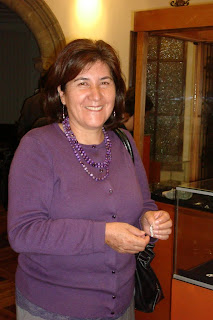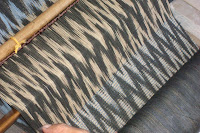Today, Friday was the last day of the first week of school for Ricardo and I. This might be a long blog as I will include our thoughts and things about life with our families and school. First a couple of quick things - we do love this city and it is very cosmopolitan and bustling as any city. There are about 400,000 people and maybe about 800 (supposedly) foreigners here. I have a feeling that this is just the beginning of a future influx of foreigners.
 |
| Yolanda's daughter Bernarda |
Our families I live with Yolanda (50 years old) and her 21 year old daughter Bernarda. Yolanda's ex, Diego is still very much a part of the family and they refer to each other as novio's (boyfriend/girlfriend). Yolanda has never cooked vegetarian before but is enthusiastic with everything I make and lets me help in the kitchen whenever I want (which is most of the time). She tells all her friends whenever we are with them about all the combinations of veggies that I have made and we are even planning to hold a "salad making vegetarian cooking class" one of these upcoming weekends. Our home is the third floor of an apartment building and it is 3 bedrooms and 3 bathrooms and simple in design. I am happy to have my own space though we all spend alot of time talking together when we are all home at the same time.
 |
| Mi "mama" Yolanda |
 |
| My house - top floor on the right. |
Richard's family is composed of a grandmother Mariana, her two daughters (one with husband) and two grandchildren and in addition, one unmarried son which means it is 7 plus Ricardo making 8 in the family - a typical latin american family. Often one of the uncles comes over for a meal. In his house he has his own room (taken from one of the daughters) but they all share one bathroom so Ricardo comes home in the middle of the day for his shower! They enjoy meals together and Mariana does all the cooking, in fact she does not even want Ricardo's help cleaning up after meals. He is getting spoiled again and I hope I do not have to send him back to "husband's training school" after our time in Cuenca!
 |
| El puente de amates - the bridge that we meet at each morning |
A typical day for us
We both meet on the bridge which is less than a 5 minute walk from each of our houses - on each side of the River Tomebamba (which runs through the city). We walk, speaking spanish to each other all the way for 30 minutes to school. Then we have classes from 8-noon with a break at 10:00 when all the students and teachers gather for snack and tea/coffee. It is a fun part of the day as we get to meet some of the other students. This school only offers one-on-one teaching and it is geared to the students level and needs. The first day I had a test and nearly freaked out and went home because it seemed so hard, confusing and I could not remember much of what I learned (or at least that is how I felt). Nevertheless, I was placed as an intermeediate and am reviewing all the tenses that I have learned with some new information and vocubulary. My teaching day goes like this - review homework, read a short story with a moral and then discuss the story, grammar review, conversation, more grammar if needed that day, reading for pronounciation and understanding yesterday a discussion on a controversial subject. Richard's teacher spends more time on conversation. Next week we will trade teachers for a few days to experience different teaching styles. At the present time our plans are to stay here for the whole month - not sure what accomodations for the whole time but you can stay tuned for that. At about noon we leave school and walk back to our homes for "almuerzo" the big meal of the day. I usually help cook and we eat together, often with some friendss of Bernarda's joining us. Richard has some subset of his family for his meal at 1:30. Then we walk back to school when their is an afternoon event (including - city tour, cooking class, museum tour or salsa dancing) every day except Friday. Then back home for evening meal and computer for me and TV for Ricardo. We have had several friends from San Miguel visiting in town so we have met up with them a few times and also have some new friends that we met at the hotel that we stayed at the first few days, along with some from school and will probably catch up with them next week.
And a little more....
Last weekend, the first day with our families, my family took Ricardo and me to two small towns outside of Cuenca that are known for indigenous crafts - one is Gualaceo and the other Chordeleg. We were able to go to the studio of a weaver who dyes all his own yarn and makes IKAT, a type of weave. Of course we bought me a scarf (and one for Yolanda too). We have been to a "panama" hat factory. Panama hats actually originate in Ecuador and most are made in Cuenca and the small surrounding towns. They are really called Montecristi - named for the most famous town of its origins in Ecuador. In the 1800's the Spaniards exported them to Panama and soon the world began thinking they came from there. They are still made here, each by hand and there are several levels of hats. Here they run from 20.00-500.00 but apparently they can be bought in the US for much higher prices. I have not chosen mine yet, but I am surely going to get one - they are very lightweight.
 |
| Weaving IKAT - a type of weaving style |
 |
| Church in Chordeleg |
Today, still Friday as I am writing, both of our teachers took us to a marketplace where indigenous women use plants, eggs, herbs, flowers, water and not sure what else to bless people and to remove evil spirits. They do this for adults and children. They also can be seen spitting some liquids on their clients.
 |
| my professor - Mayra |
 |
| Richard's professor - Patricia |
 |
| in the market |

